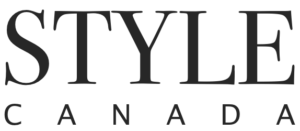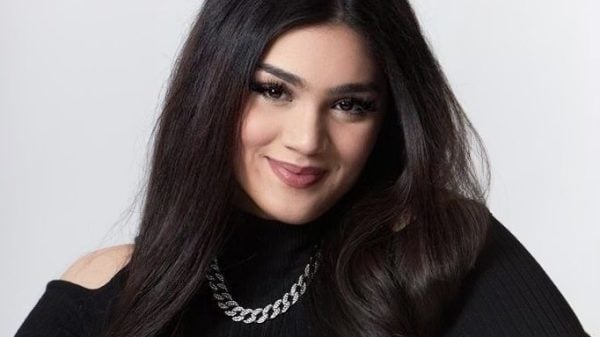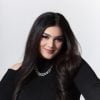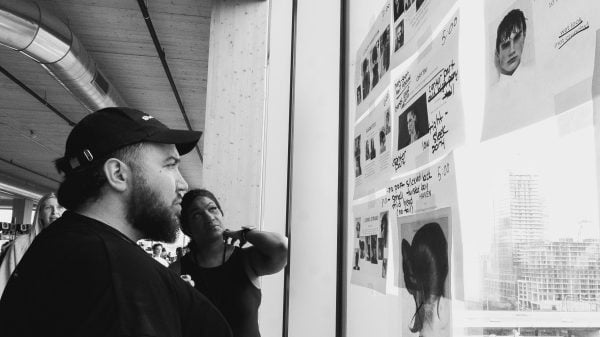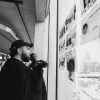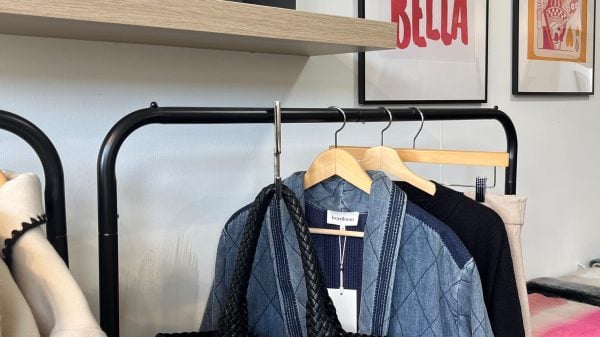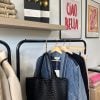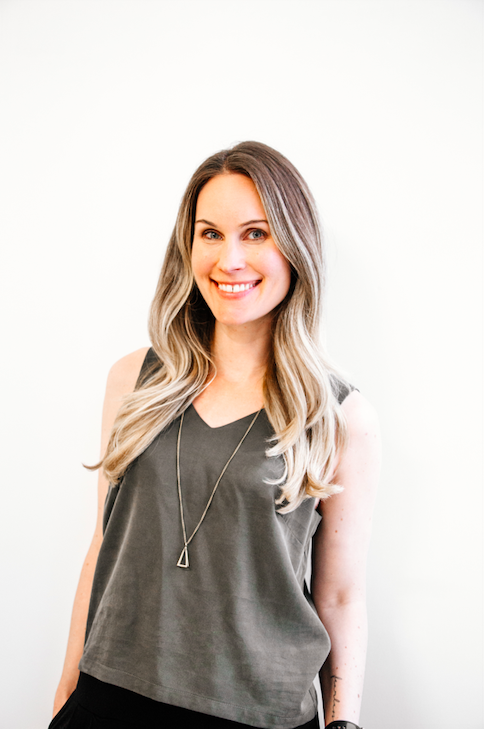
Photo Credit: Kristi Soomer
On this week’s Let’s Talk About… episode, Elise sits down with Kristi Soomer.
Kristi Soomer is the founder of Encircled, an ethical clothing line made from the finest, most soft, and flattering eco-friendly fabrics. She is a self-made entrepreneur with a background in financing consulting with an amazing team. She also has her own podcast, The eCommerce Maven Podcast, where she talks about growing product-based businesses through online retail.
Elise and Kristi talk about switch careers, from strategy consultant to CEO, the journey of Encircled, and the importance of sustainable fashion.
“But textiles are a huge source of waste. Oftentimes they’re just thrown out like the excess fabric from cutting is just thrown in the landfill. And depending on what it’s made from, it may be there for your lifetime.” Kristi tells Elise on Let’s Talk About.
To listen to Kristi’s episode of Let’s Talk About, simply click here or search for “Let’s Talk About by STYLE Canada” on any major streaming platform.
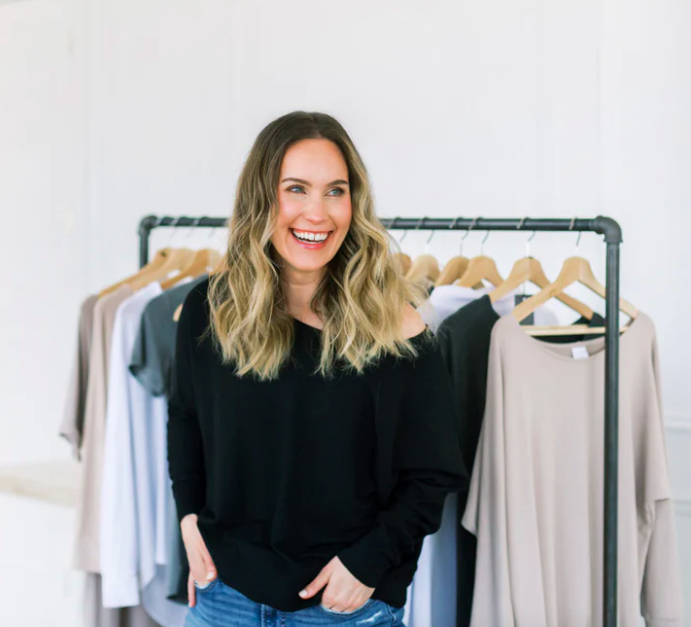
Photo Credit: Kristi Soomer
Check out the show transcript below.
[00:00:00] Elise: Hi, friends and welcome this week. We’re talking about sustainable fashion with the founder of ethical clothing line Encircled and Kristi Soomer. Kristi is a self-made entrepreneur with a background in financing consulting with an amazing team behind her.
She has managed to grow her business ethically and is one of Canada’s fastest growing new. In her personal life. Kristi is a surfer traveler in total business geek. She’s a proud puppy mama and loves reading, listening to podcasts. She actually has her own and spending time with friends. Kristi, thank you so much for being here with us today.
[00:00:33] Kristi: Oh, thank you so much for having me. It’s such a pleasure to reconnect with you.
[00:00:36] Elise: Yeah, I, the last time I think we saw each other was January 2020.
[00:00:43] Kristi: I know. Oh, wild. Right.
[00:00:46] Elise: Little did we know what the next month or two would hold.
[00:00:50] Kristi: I know I’d just gotten back from vacation too. I wish I had extended it a few weeks.
[00:00:56] Elise: Yeah. I, I think that’s the same. I think I had just saw you and then went on vacation and then yeah, didn’t leave the house again for a couple years, but anyway, nice to chat with you virtually. Hopefully, we’ll get to see you in person soon. You obviously have worked really hard to build an ethical clothing line and encircled, but I’d like to take a few steps back. And cuz you do have such a background that I think is interesting in terms of how you got into the world of entrepreneurship. I know that I know it, but I’d love for you to kind of start there and share that with the listen.
[00:01:37] Kristi: Sure. So I am not a fashion designer by trade. I would call, I wouldn’t even call myself a fashion designer, more so by passion. So my background is pretty much all finance, marketing, and consulting. I started my career at a retailer called Luen straight out of, you know, undergrad with. My finance degree, working in operations there.
So that was really my first exposure to the fashion industry. And I was really on the periphery there cause I was in operations, the stores, I didn’t really get much exposure to their supply chain. The one thing that I do remember from that job is that they did a lot of retouching of models.
[00:02:11] Elise: well, me, yeah. Liz does list it still.
[00:02:16] Kristi: It’s owned by Victoria’s secret. So they bought them. Oh, okay. Yeah. Maybe like a while ago, like maybe like 10 years ago, but they would sometimes miss on the Photoshopping and like an elbow would be like triangular or something. So I just remember like thinking that was like my first inroad to fashion and thinking, wow, this isn’t real, like that’s crazy.
These women don’t look like this. So it was actually a really great learning experience. I worked with some amazing mentors at that company, then I decided to move industries. I went back to school, actually did my MBA at Queens I really had a desire to get into management called consulting.
I know that’s such a weird aspiration, but I just really liked the idea of it and I thought it’d be super challenging and really good with my skill set. And I’ve always had like a bit of like ADD with projects. So I like switching things up. So I thought it would be a neat fit since you rotate projects a lot in that type of role.
So eventually I did get into consulting. I worked for a retail consulting division of PWC. I was actually hired ironically by my original manager at Lunta who ended up there. So it’s always a good story to tell people to never burn bridges, cuz you never know where those opportunities will land you.
Um, and yeah, I really, I really loved it cause I got to work with so many amazing retail brands and you know, sea level executives and. Into conversations I would’ve never had, you know, and I was only probably in my early thirties, maybe late twenties at this time. But it also opened my eyes, I think, at that time to a lot of other things.
So I started to really, you know, in your thirties, you start to really think about like, what am I doing with my life? Like, what is the meaning here? And I start to get a little bit more curious about my impact and, you know, while putting together a slide deck and presentations and helping do reorgs and strategy was really challenging.
I was always questioning. You know, is this a brand that I’m helping, you know, further a good impact in the world? Um, and how does that align with what I believe, um, in my heart and who am I really helping here? Um, so I started to become more curious and ask questions and I started to kind of do a little bit of my own, I guess, research into ethical fashion and sustainability and stuff like that.
And then it really wasn’t until like an ad hoc vacation, you know, at consulting, they have something called on the bench or on the beach where you’re not assigned to a client and my friend was. Going on a yoga retreat, they have a spot, somebody canceled. Do you wanna come? I was like, I’ve never done a yoga retreat.
What is that? Let’s do it. So I was packing for it literally like the night before the flight was leaving at like, I think 7:00 AM. So, you know, for Toronto you have to get to Pearson at like 4:00 AM. Sorry. And then my zipper broke on my suitcase and it just like popped open and I. Oh, my God, everything’s gonna have to go on a carryon.
This is not good, not good. Cause I was bringing like yoga, mats blocks, all the things. Um, and then I just started in that moment. It was a trigger for me cuz I started questioning like why was I bringing all of this stuff? Like I was bringing like right sweater for the plane, a dress for here, a dinner dress at this thing.
And it was just like, none of this is really like some of these could be like double duty. Like what if I actually created something that you could wear multiple ways that would look really stylish, but comfortable and travel well? and that kind of inspired our first product idea, which is called the Chrysalis Cardi.
It’s an eight one card, right. Minute card game. That’s still in our collection today. Yeah. Um, and that came out of that one spark moment. And then the company kind of just grew out of that. So you
[00:05:39] Elise: had, well, I love that story first off because I a hundred percent can relate and I think even more so, and I don’t wanna get too far ahead of us, but I think even more so coming out of COVID now and analyzing our wardrobe and seeing that we really didn’t wear a lot of it.
And I know myself I’m looking for those pieces. That could be like multifunctional mm-hmm , but let’s, let’s go back. Uh, cause what year are we in right now with that?
[00:06:05] Kristi: Yeah. So we’re in, we’re in, 20 12.
[00:06:10] Elise: Way back throwback. Yeah. Well, and I ask that too, because I think, you know, when we talk about sustainable fashion ethically made, like, we’re all more educated on that now, but I, I really, and you can tell me better in 2012, like, what was the temperature around that?
Like, was that even a thought? Cause I have personal story that I’ll share with you after, but you go.
[00:06:32] Kristi: Yeah. Um, not in the industry for sure. No, it was not, you know, that was around the time. I think the next year was when there was the unfortunate incident with the ran Plaza, factory collapse in Bangladesh, where there was a bunch of clothing brands involved in that and thousands of people died.
Um, and that broke some awareness, I think, around the ethics of fashion. Um, but sustainably, no, nobody was talking about it. Nobody understood it. Um, it was very nebulous, but it was very important to me. because as I mentioned, I am a surfer. I travel a lot. I started to see around the world, you know, stuff that you don’t see here.
Like we put our recycling away in a bin to the curb, and then there it goes. Um, but in a lot of more developing countries, like a lot of the garbage was starting to. Float in the water and you know, I’m surfing and I’m getting like sludge on my arm, like, oh wow. You can’t like ignore some of this impact.
Um, so sustainability was a really core, important value. And so was the ethics and so was local. Um, and having that local production was a huge benefit to me at the beginning for anybody starting up a business, especially in manufacturing, like there’s nothing like building those local relat. Because you can really monitor the quality, you’ll get smaller batches, you can kind of move a little bit slower and kind of go into the business at your own pace.
Um, and it’s incredibly sustainable to produce locally too. So there was a lot of factors. I was definitely out on my own, like people were like, what are you doing? And why are you making here? Like, it was weird. It was weird now it’s not weird, but it was weird then
[00:07:56] Elise: for sure. Right. And I think as you’re kind of going through and talking about locally made and you know, now there’s supply chain issues and all like all these things, these things that you were thinking.
When you just wanted to invent this card again in 2012 are now like more, I don’t know if the word is accepted or more thought of than at the time. So let’s go back to 2012. And so you have this idea mm-hmm how do you know right away that you want it to be ethically made like locally made like all of those components or how take us through that journey of how like the finished product came to be that one cardigan came to.
[00:08:33] Kristi: Yeah. So it started with the fabric because I had had this piece from, um, oh my gosh. I think they’re. American apparel. Um, and it was like a 40 and one scarf. And it was basically this thin piece of fabric that was cut wasn’t even hemmed, um, that was see through. And you could wear 40 different ways and it came with this little card and showed you all the ways you can tie it.
[00:08:56] Elise: But you’d have to wear something under
[00:08:57] Kristi:Iit then each time yeah. See through, and it looked like you were wearing a potato sack. It was so not flattering, but the concept was really interesting to me. So I was like, if I could do this better, like I could put snaps or some sort of closure, um, to, and maybe we don’t need 40 things in one.
Maybe we just need eight, um, and better fabric and more sustainability. There’s lots of ways to make this product better. So it started with the fabric. Because I wanted a really nice fabric that was resilient and durable, but luxurious. So immediately I gravitated towards a fabric called mum, um, because I’d had quite a few pieces in my wardrobe made from that fabric.
And I knew that it just had this like really luxurious texture to it. And through learning about, I realized, you know, what, there’s sustainability aspects of, um, you know, our supplier that we got it from initially and still work with today, you know, they have all these certifications, it’s sustainably sourced it’s lens.
So it’s certified it’s ERCOT tax, a hundred certified to be free of harmful chemicals. Um, and it’s a really resilient and beautiful fiber it’s often found. I’m sure as you know, in, in underwear and stuff like that. Typically not as commonly found in mass fashion and garments, because it is so expensive.
Um, but it’s a great fabric. So that’s kind of where we started with the sustainability. It came from both a function and sustainability. Like, I don’t think I would’ve picked hemp just because, oh, it’s sustainable. Like it had to really work with the garment and all the ways we wanted to style the garments, that it was something wearable for the customer.
Cause I think to your point up until then sustainable fashion really had been like. Line in pants and like hemp, you know, tuna. Yeah. Like it didn’t have the cache that it has now. Right. So it was a little unusual to be even using sustainable fibers, to be honest. Yeah. And I
[00:10:37] Elise: think kind of like people thought of it as like more of a granola sort of feel like I remember doing a pitch competition and this is the story I was gonna share.
We were producing a SU a sustainable product. And the, and these were CEOs. I probably shared this story with you before. No, but they were CEOs of like major, it was in New York major, major, like conglomerate brands. Mm-hmm . And after we got our feedback, the feedback was kind was basically like great product.
Like the sustainability though is not gonna be what sells it. So you gotta come up with another kind of. Marketing angle. And now I feel like that’s prob I mean, this was, this was probably like 20, 20 17, 20 16, maybe mm-hmm . Yeah. I’m not great with the dates, but anyway, that’s, I would say that that comment would’ve happened, um, in, in a competition that was happening today.
Right. For sure. Um, So you find this fabric that you wanna use, you know, from how did you, I guess this is kind of just, how did you get it actually designed? Cause you weren’t a designer, so you produced it locally. You mentioned, or did you from the start, did you produce it locally or was there a
[00:11:51] Kristi: process there?
Yeah. So, um, initially I started with, um, the Toronto fashion incubator, um, in, oh yeah, here locally. It’s a notfor profit. Um, I wasn’t part of the incubator, but I started taking their classes. So they have like some workshops and stuff like that. They factory list you could buy. Um, and they also had a resume bank.
So I had pulled some stuff from there and, and I figured enough out from online, I bought this book called the stone product, uh, stone entrepreneurs guide to product manufacturing, very boring book, very expensive. Cause I had to buy it on eBay cause it is at a print. Um, but it tells you everything you need to know about making a garment like.
And it’s so boring, but it’s so essential. So I always recommend that book to aspiring fashion designers who are not coming from the field or even somebody who’s gone to school. I think it is important to commercialize. Um, so I’ve had that book. So I knew I needed like a pattern. I knew I needed a technical designer of some kind.
Um, but the garment at the end of the day that I was making initially at least. Fairly simple in its iteration. I’d already made my own prototype. So I’d brought, I gone on Craigslist at the time. That was acceptable. Yeah. Um, and bought a sewing machine for like $40. I broke it on the first try cuz I’m not a seamstress.
Um, had to have it fixed on queen street, brought it back, um, and started playing around with different fabrics. I found it sample shops on queen street and different attachments. And literally I have photos from my first apartment of like a dress form, Judy with a thing on and I’m pinning it anybody who came my condo was like subject to like being a fit model. Cause I cutting it. Yeah. So I did a lot of like iteration with it, to be honest. And then when it came to doing the pattern, um, I had like a pattern maker do the pattern, but it was really, I mean the pattern is very simple. It’s just like a rectangle. Um, and then you mark the cut pot, the cut points and stuff like that.
So I found her through a referral on Toronto fashion incubator. So, um, that was like really where I started. I think now. So many amazing resources out there online for designers and forums and Facebook groups. I mean, that kind of stuff just did not exist at that time. Right. So it’s a lot easier for people to start out fashion brands with no fashion knowledge today.
Um, probably more than ever.
[00:13:58] Elise: Mm-hmm so you have this one card again, and it is it’s locally made. It’s sustainably made. Where did. Turning point, cuz now you have, I guess now you’re, you’re coming up with the brand, you have the product. So what kind of went through your mind when you I’m assuming at this point you knew that you wanted to make it ethically.
Cause although it kind of seems like it happened also organically that aspect of it. Um, but what, what other barriers, I guess, to creating something ethical, sustainable at the beginning were there and then I’d also love to kind of jump to today. And what that environment looks like today versus then
[00:14:37] Kristi: mm-hmm
Yeah. So first of all, finding somebody to make this product was incredibly difficult because, um, this product specifically is very technical, even though it’s simple. Um, because we use, um, the way it works is it’s essentially a big circle scarf, and as strategically placed. Hand sew snaps. That’s important.
Um, manufacturing and garments, as we know is still very handmade. Um, but they love to avoid hand sewing if possible, cause it’s very expensive. Right. But it’s very necessary with this type of fabric to do it that way. So first of all, nobody wanted to make it. I contacted all these people and they were like, no, thank you.
[00:15:11] Elise: You had this full list. No one wants you to
[00:15:13] Kristi: do it
yeah. I had like a list of 50. Um, and there’s a lot of them are out of business to be honest, like we called a lot of them. They’d be like, the number was dead, whatever. Um, I found a short list, went to meet with them. They wanted to, um, a few of them wanted to change the design cuz they thought it made no sense.
And I was like, no, no, no. The secret is that you don’t see the snaps. That’s why it looks like a dress when it says a dress and they were like, we don’t get it. Um, and then I found this one factory of in Markham and I don’t know if like the operations manager. Like liked me cause he had a daughter, his like around my age, but mm-hmm he was like, yeah, we could try and make this.
I think um, and he took us on, so he, he made like a prototype. So usually you go through like a sampling. So they made like an on the production line prototype looked really good. Um, then ordered the fabric, had it delivered and then what off we went on the first production run. Um, and the funny story is that like , at the time I’d sold my car to like fund the business and, um, I rented like a smart car and I had to go pick it up and I didn’t realize it would be in these huge boxes.
So like literally I was driving on the 4 0 1, which is like the biggest highway in Toronto. It’s like 12 lanes for anybody who’s not from here. Um, and a smart car with like stacks of courtes to the ceiling, you know? Um, so it was really grassroots how I started. And like I started shipping from my apartment.
It was my side hustle, so I was still employed. So I would work on evenings and weekends, mostly weekends. Cause I traveled a lot as a consultant. Um, and I would engage my friends and ask them to help me ship for pizza and stuff like that. Um, so I would say we started off like. Creating the brand round and circle just came to me.
I think when I was creating the product idea, cause it’s essentially a circle, but I also wanted this idea of like full circle fashion. So something that would benefit, you know, our customers and being a really high quality product and adding that versatility, but something that would also. Um, create, create equity with, um, the manufacturers and our planet.
So I had this like kind of visual there. Mm-hmm um, and so that’s really how I came up with the name. Then I just Googled the crap out of it to make sure nobody else was using it on trademark right away. Smart, smart. But I will say like when I did launch, I didn’t know as much as I know now about digital marketing and the landscape was quite different.
So I hired a PR firm and did that thing for a few months, and then we had some strong sales initially, and then it just totally like I had no marketing plan. I’ll fully admit it and it totally dropped off. And I remember, I always tell the story, cause I think it’s really important. Um, for people who are starting out to hear like March, 2013, I did $128 in sales and that was one garment.
to a friend who paid cash. She didn’t even use my website. So I literally almost say no sales. Um, and I, you know, every entrepreneur has that moment where they’re like, what? This is not possibly a real full-time job, you know? And now we’re, you know, we broke seven figures in revenue years ago, maybe like five, six years.
[00:18:02] Elise: Ago’s amazing. So we’re in. Full team,
[00:18:05] Kristi: full team and stuff like that. So it’s, it’s very different now, but you got, everybody’s gotta start somewhere. Right. So totally. Um, so yeah, the landscape’s different for sure. Now
[00:18:13] Elise: can we, and we’ll get into, sorry. I, I mm-hmm , I’m gonna cut you off mid, mid, um, getting into what it’s like now, but because I am curious to hear not so much about sustainable fashion, this question, but more about entrepreneurship.
What kind of. What turning point was it? That was like, okay, I’m okay to leave my job. Mm-hmm right. And become a full time entrepreneur. Like what happened there? That was it just a leap? Was it like something financially happened? Like what made you feel like now was the time to take this to the next level and do this full time?
[00:18:47] Kristi: It was an incredibly hard decision. First of all, like, um, I’m single. So I have a single income, you know, so making that jump with no safety net and I wasn’t paying myself out of and circle at the time was very scary and I’d worked, you know, like many people, very hard in my career. I was not new in my career.
I’d been in my career for almost 10 years, um, which is like leaving a lot of that behind. But, um, I had a really good friend tell me like something reassuring and maybe it’s obvious to people, but like, you can always go back. So like, if you decide right, this is I’m going for this, um, there’s no shame in going back and getting a job if you have to.
Um, but I think I felt a lot of personal, like shame or fear around that, to be honest. Um, plus my parents I’ll be transparent, were not very supportive. They’re not entrepreneurs, you know? Um, my dad’s a lawyer. My mom was a teacher librarian for a number of years. They’re very traditional. Um, and they didn’t think it was a good idea at all and it’s a while to come around. So I think when you have outside forces inside forces telling you, no, it does take a lot of internal power to make that decision. So…
Absolutely.
It wasn’t until two years into encircled part-time that I made that decision. Um, and it took me a while. I quit my job three times, they talked me back every single time um, and then eventually let me go.
Um, but it, it was really difficult and I think. It was a multitude of decisions around, you know, financially. I felt like the business was growing a lot, but it. It, it was expanding my capability. Like I couldn’t do more. Um, right. And it was kind of hitting that point where it’s like, either you’re gonna make the leap or this is just gonna become what it is.
And I was like, this feels like too much of a thing. Like I can’t give it up now and I loved it so much. So mm-hmm I just was like, well, this is what we’re doing now. So ,
[00:20:31] Elise: I love that. And, and what year was
[00:20:34] Kristi: that in then? That was like late 2014. So
[00:20:37] Elise: 2014? Yeah. Okay. So you’ve been an entrepreneur now for eight years.
Hmm. And so from. That, you know, one, one item and, and thinking of what this brand could look like, looking back on it, like you, I mean, there must be such a sense of like accomplishment and although I think as entrepreneurs, you don’t often get a chance to look back on it either, but yeah. What would you say in those past eight years, like you are most proud of?
Cuz I know in circles has had some pretty big accomplishments, like. Through COVID till present day and before then as well. But can you share some of like those high points in the journey and some low points if you want as well, but as it relates to, to like two sustainable fashion and like different certifications and things that you, you went after.
[00:21:22] Kristi: Yeah, absolutely. Um, I think one thing that we’re very proud of is our B Corp certification. So we were able to become a certified B Corp in 2018. We just re-certified recently, um, you know, up until recently, we were only one of, I think, five apparel brands in Canada run by women, um, who were, who are B Corp certified.
So that’s a very elite. Um, that’s and many amazing brands like Eileen Fisher, as you know, is a certified B Corp. So it really elevated us and it elevated the brand and our education around sustainability and ethics in fashion. Um, and it’s incredibly difficult
[00:22:00] Elise: to get too. So I was just gonna say, yeah, I don’t want you to move on, cuz I’d love for you to share a little bit about what’s involved in, in a B Corp certification, cuz it is incredibly
[00:22:08] Kristi: difficult to.
Yeah. It’s like a full internal audit of everything you do from how you pay your employees, to where your suppliers are located to, um, you know, governance of your organization to sustainability standards, waste disposal. So it really looks at everything and there’s an assessment that you take. And then generally that assessment identifies opportunities for improvement.
Um, and it scores you. So you have to get a minimum score to even get like into it, but then there’s opportunities to improve your score. As well. So, um, you know, when we initially started it, I think our score, I don’t know the exact score actually, to be honest, but I think it was in like the nineties or something.
And then we were able to improve it to well into the hundreds, um, in the last certification, through just like those best practices that they have, those things again, like sustainability is a very new, um, area of the industry. So a lot of us are just kind of learning as we go. And sometimes that’s tricky because you can feel.
Oh, like I did that before, and then you’re like, Ooh, that wasn’t sustainable. But like the knowledge is evolving so quickly in this industry. It’s like, we’re all trying to like learn with it. So I think being a part of a B Corp, um, certification is important because it does expose you to faster learnings that we can all be more impactful brands on the planet and people who live on
[00:23:22] Elise: it.
mm-hmm . And can you share some of, you mentioned some of the other brands that you’re kind of going through this process with. Can you share, like when we’re out there, you know, looking in this space, what other brands you should kind of keep an eye on and, and work to support besides obviously in
[00:23:36] Kristi: circles?
Yeah. Yeah. There’s some great, um, Canadian, B corpse out there. Um, Poppy Barley is one they’re shoe brand, uh, run by two amazing female entrepreneurs out west. Um, there’s also cotton K O TN they’re based in Toronto. Um, they’re a certified B Corp and has a lot of sustainability rooted in their supply chain over in Egypt.
Um, you know, Warby Parker is a very well known B Corp in, in the states. Um, Ben and Jerry is one of my favorites. um, they’re B Corp, um, Patagonia. Um, so it’s really a, an amazing set of brands that, um, are in there. I mean, just getting exposure to that is, is such a win for us as. Yeah, you’re in good
[00:24:18] Elise: company there mm-hmm so what’s next for encircled?
What do you have kind of, and whether that’s from a product perspective, I know you have some exciting things on the brand side mm-hmm would love to hear what’s coming.
[00:24:30] Kristi: Yeah. So, um, yeah, we’re, we’ve got lots going on. So we’re doing a lot of work right now on our website. Um, we’re actually working on a complete visual identity refresh, as you mentioned, like I’ve been an entrepreneur for eight years.
The brand has been around for 10 years. So I felt like it was time for us to really work on elevating our brand presence. We’ve done a lot of bootstrapped brand design. Um, our first logo I design. So
[00:24:54] Elise: that’s usually how it happens, right.
[00:24:56] Kristi: Yeah. um, so we’re launching a new website in early July. Um, it’s gonna be full multicurrency so people can shop in their local currency.
Um, we’re, we’re moving actually our, our warehouse offsite as well for faster shipping options as well. So, um, and we’re continuing to develop new products and innovate in sustainability. So we really wanna start focusing on. Improving our renew collection, which is a collection of items that are all made from upcycled production.
Cutting. So we’re challenging some of our design team to come up with ideas for higher usage of leftover fabrics from production and cutting. Um, and then we’re also working on just some really nice designs for the fall. So I think it’s an interesting time for us because, uh, literally the world has been working from home.
A lot of people for almost two years now, they’re going back to work. People don’t wanna go back to wearing this uncomfortable pants suits. I mean, I
[00:25:48] Elise: don’t absolutely not. Which I think, yeah. Which must be, be great for business right now for you. Cause I would like from your product lens standpoint, not only do we hit all those things, you know, made local sustainable, all of that, but like from, just forget all that for a second, it’s still pieces that you would want to wear.
Especially coming out of COVID. Right. And like, we don’t wanna try to fit into, I don’t know that like type all least I don’t wanna try to fit into like that type pair of jeans or whatever it might be. Right. Yeah. Or those high heels, whatever it is. Yeah. Um, so yeah. Are you noticing. Are you noticing like a shift in that consumer behavior as well from a sales coming your way?
[00:26:32] Kristi: for sure. We’ve had a lot of shifts over the last two years and I’m sure a lot of brands have like, you know, um, fairly early on in the pandemic, we started making masks. Because we had the local supply chain to do that. Right. And that was something we were very, very proud about, um, doing and supporting the community in that and donating masks as well.
Um, and then we almost ran out of inventory because the supply chain in Toronto was very shut down for a very long time. So, and then we got heavy into lounge work cause everybody was into, you know, jogger sets and stuff like that. Mm-hmm . . So what we saw was like, obviously decline in some of our more dressier pieces, but the biggest resurgence this year actually has been in a piece that’s been in the collection for almost seven years.
Uh, our dressy sweatpants, that pan, okay. We launch fire this year. We just launched. We launched up to four X last year. We just launched petite in seams. We’re launching tall in the fall. Amazing. Amazing people cannot get enough of that pant because it is, it’s literally a dressy stuff hand that you can wear, right.
Nobody will ever. Um, so, and, and our comfy wide, the dream pan. Yeah. Yeah. And we redid our comfy wildlife pants this year. It’s made of the same kind of pajama soft material, but looks like a dress pan. So that’s really our like secret sauce is dressing you up for work so that you look, you know, professional and put together and polished, but you’re literally in your most comfy clothes that you could lounge with on the couch if you wanted to.
So those types of pieces have been doing real really well for us. And then the Chrysalis card still in our collection hanging on, you know, had a rough couple of years. COVID no travel, but, um, starting to see resurgence there now with people getting out there and wanting to travel again and especially travel light because of the yeah.
Lineups at the airports and stuff like that. So it’s interesting to see those waves shift and it’s, it’s hard in fashion as you know, to predict what’s coming. Um, right. But especially over the last couple years, but so we’ve definitely made some bets that did not work out. Um, but I think we’re really honing in on where we’re the best at.
And that’s really that company dressy value proposition look yeah.
[00:28:27] Elise: From, you know, We obviously know from a fashion lens, like it’s hard to predict the trend, like you just said, mm-hmm but from a sustainable fashion lens, is there anything that you see on the horizon that. Whether or not, you think it’s gonna be a trend, but you think maybe just yourself think is really interesting.
Mm-hmm that you
[00:28:44] Kristi: can share. Yeah. There’s a couple things. I think one thing is definitely the resale market is very interesting. Mm-hmm and brands taking ownership in the resale, um, market. So you you’re starting to see it a little bit. I think you’ll see it more over the next year. Um, brands launching their own kind of resale platforms within their website.
So that if you have something from, I think Lululemon just launched this, um, if you have something from Lululemon and you’re not wearing it anymore, instead of using Poshmark, they’re creating their own market for that. Um, that’s definitely a huge trend that I’ve seen happening.
[00:29:14] Elise: I’m happy you brought that up.
Cuz I, even some of the luxury brands have, have seen them started, which are probably like the. Some anyway, slower to adopt to that. So, yeah. That’s a great point. Thank you for
[00:29:25] Kristi: mentioning that. Yeah. Yeah. Um, definitely material innovation, for sure. There’s a lot of stuff happening that’s been happening for years, but because the big brands haven’t been interested in it, um, the commercialization of some of those fabrics has been nearly impossible, meaning that they’re not an accessible price point for anybody to use, to put into a garment.
Normal person could buy. Um, okay. But we’re starting to see like that mushroom leather and stuff like that. Um, go into more mass production so that now it becomes like more accessible for slower fashion brands to use it as well. Uh, which is pretty cool. Um, and then I think the third thing is probably regulations.
So we’re starting to see, um, specifically I think of the EU, but I think it will come over to Canada and the. Some point more regulations about what’s sustainable. Cause we’ve seen an increase in greenwashing. I don’t know if you noticed this on, um, this recent earth day, but it felt like it was like a retail holiday or something like that.
Everybody was launching an earth day collection and I’m like, this is not the point of this. Yeah. This is the point of awareness for the earth and the climate crisis and emergency that we’re experiencing. Um, so I think you’ll see a lot more regulation and therefore I’ve always been a bit, um, You know, thoughtful about this, but I do think sustainability at some point will become table stakes to grants.
And I think it’s an important one because we all have to take ownership over our impact on the planet and that’s through government regulation. I think that’s the only way they’ll get there is by folding companies accountable to that. So while I think it’s important for us to do it anyways I think it will become something that brands will kind of have to do in order to participate in retail.
[00:30:59] Elise: Do you in, in some of the, you mentioned earlier some of the other brands that you might work alongside, do you, how does that government regulation come to be like, are you getting approached by whether it’s politicians, et cetera, to kind of push that agenda forward? Like do, do fashion brands have a hand in that? And if so, like what does that look?
[00:31:21] Kristi: Yeah. Not really, to be honest. They tend to go to more industry stakeholders like factories, um, fabric suppliers, um, you know, something like fashion takes action, which is a, not for profit. They would probably work with them. I have been part of some groups like a pre pandemic.
There was a huge thing around textile recycling that they were looking into in Toronto. And I was part of that kind of. User group and, and helping kind of explain our process and how that might work, because from some people may not know, but textiles are a huge source of waste. Oftentimes they’re just thrown out like the excess fabric from cutting is just thrown in the landfill. And depending on what it’s made from, it may be there for your lifetime. Um, so finding that to textile recycling, there’d been a pilot going on in a suburb in Toronto that was quite successful. So they were looking into that as well in Toronto, but. You know, everything kind of shut down with uh COVID. So I’m hoping some of those projects will reinvent themselves.
Um, and there’s not a big priority, unfortunately, I would say in the last couple years towards this, because a lot of government resources have been diverted mm-hmm . However, there has been, as I’m sure you know, and have seen a huge resurgence of shopping local on reassuring to Canadian manufacturing.
There’s like a whole Ontario made initiative now that’s fueled by the government. So there’s all these initiatives bringing awareness and grants and more of that focus on local, which I think is incredibly important to starting that ball rolling. Because I think people forget that, like, you know, there’s still not, I think not a lot of people think about where their clothing comes from and that’s totally fine.
Cause I was there too. But the more you think about it, you’re like, okay, well, in the nineties, you know, we’re talking about like 80% of the clothing worn in Canada, early nineties was probably made here and now it’s like probably two or 3%, something like that. Maybe it was a little bit in the pandemic, but it’s really low.
Um, so, you know, thinking about that and how we can make more informed choices, I think is really important, but I think sometimes the facts just Aren. Out there for consumers to even consumer be aware of. So fashion revolution is a great group. That’s been doing some amazing work globally as well in Canada to bring that awareness and do some government lobby being as well.
[00:33:28] Elise: I appreciate you mentioning some of these groups that are doing, doing some good work, I think. Is there any other, um, resources, whether it be like podcasts, even your own or books ex you mentioned your more on the design side, but more on the sustainable fashion side things. If people are curious to learn more, they should have a look.
[00:33:46] Kristi: I would definitely encourage them to follow us on Instagram @Encircled_. We do a lot of education on our Instagram platform. We try to really lead with that so that consumers can make more informed choices, whether they shop with us or somebody else. Um, the other thing I would recommend for people, especially if they’re just getting their feet wet with sustainability is watch a documentary called the true cost.
There’s another one called river blue, which is really good. It’s about the denim industry. Okay, those two will change your mind on what goes on in the fashion industry and are very approachable and provide the information I think in a really digestible format, there’s a lot of publications and blogs and stuff like that.
[00:34:36] Kristi: So the true cost and river blue highly recommend checking them out, and follow us on Instagram.
[00:34:43] Elise: Amazing. Well, it was so great chatting with you. I appreciate you taking the time and nice to just catch up, see your face again too.

